Elekit Japan is not your typical audio company. Their core business is in fact not audio, but the design and manufacture of educational electronic kits. Perhaps it is because of this unique background, they are more willing to exploring the different paths to music enjoyment. The new TU-HP02, the company’s second portable amp, best reflects that idea by purposefully introduces distortion that mimics the sound of a tube amp. The idea is however not as outlandish as it sounds since it has been tried by others in the past, though this may be the first portable amp to do so, or at least to my knowledge.

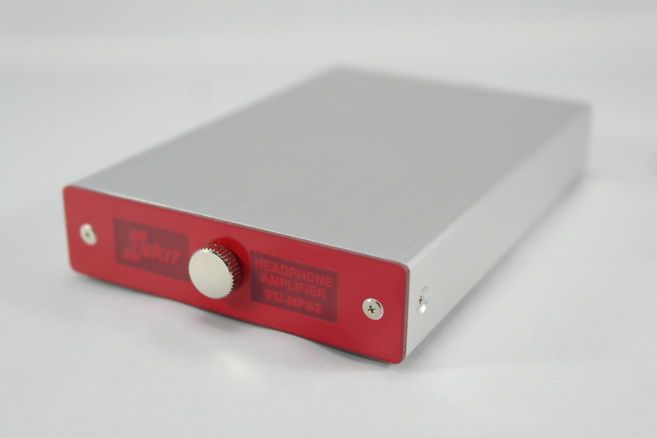
Spec
Recommended Headphone Impedance: 16-300ohm
Maximum Output: 170mW @ 16 ohm
Frequency Response: 1Hz-230kHz (-3dB)
Power Supply: 4 x AA battery or 4 x rechargeable NiHM AA battery
Power Consumption: Approx. 40mA (no signal) or 60mA (10mW @ 16 ohm)
Battery Life: Approx. 30 hours of continuous use (10mW @ 16 ohm)
Dimensions: W75 x H19 x D132 mm
Weight: 175g [excl. batteries]
MSRP: US$245
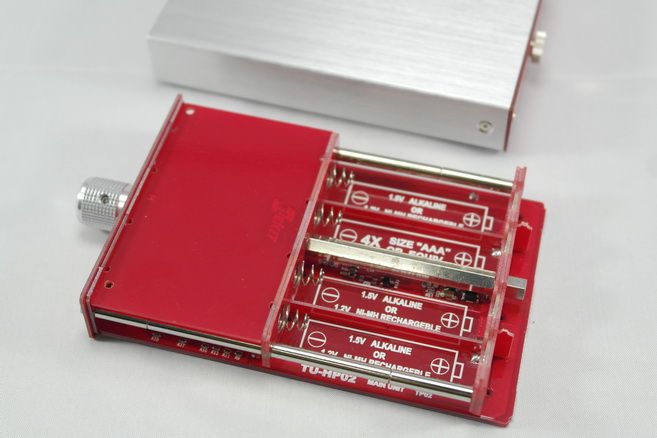
Build Quality
Like the TU-HP01 I have reviewed before, the TU-HP02 has an excellent build quality. The one I received for this review is a pre-production unit so some of the marking are wrong, but otherwise it should be identical to the retail version. The amp takes either 4 AA size batteries and they can be either alkaline or NiHM rechargeable. The front and back panels are basically the same material as the PCB, which is the same style as they have done it on the TU-HP01 and to be frank, quite to my liking. Unscrew it on the back and the whole PCB and front panel will easily slide out of the housing for battery exchange. Battery life is estimated to be around 30 hours depends on volume and load, which is pretty good consider they are running on AA batteries. I am actually still on my first set of batteries as it seems to go on forever and I just give up trying to drain them empty after the first 10 hours.
Gain, Hiss and EMI
Based on my measurement, the two gain settings are rather far apart, with low gain at about -8dB and high gain at around +9dB. Those these number seems a bit more extreme, it actually works out rather well in practise. The low gain setting work best if you have a high output source (i.e. a FiiO’s DAP with well over 1Vrms of line-out) with very sensitive headphone to prevent clipping, while the high gain setting works best with low output source (i.e. Sony’s DAP with under 0.5Vrms of line-out) that needed the voltage boost. They are far more versatile than that of TU-HP01’s gain settings to say the least.
Another area that shows good improvement is hiss. The TU-HP01, being an actual tube amp, suffers from microphonics and the resulting hiss. TU-HP02 on the other hand has no such problem. Hiss is extremely fainted (and arguably inaudible) even with maxed out volume in high gain on my most hiss-prone IEM.
EMI is also excellent with no detectable interference from a cellphone making/receiving call in close proximity. Click and pop during startup is fairly well behaved too.
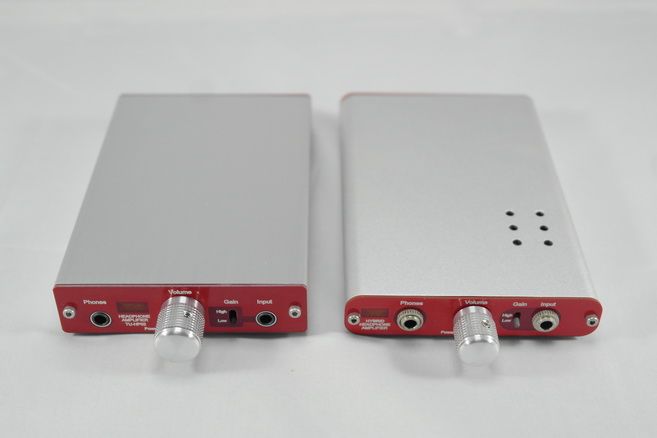
TU-HP02 (left) and TU-HP-01 (right)
Tech Prelude
So what exactly is this tube’s distortion Elekit has designed into the amp? Well, it is basically referring to the harmonics distortion that comes with a typical triode tube gain stage, and most importantly, the second harmonics that is associated with added body, depth and richness to the fundamental (i.e. with a 1kHz fundamental, the second harmonics will be the double at 2kHz, so on and so forth). Inside the TU-HP02, Elekit has designed a full discrete amp stage that recreates these harmonics distortion and they refer it as the ‘trioderized’ sound.
Sound Quality
As usual, the sound quality evaluation starts with some basic measurements. As far as RMAA’s result goes, TU-HP02’s noise, dynamic range and stereo crosstalk number are pretty good and close to the reference O2. As expected, intermodulation distortion and total harmonic distortion are both noticeably higher due to the purposefully implemented tube-like distortion circuit, though the number are still below the 1% threshold. Frequency response is flat from 20Hz to 20kHz. Output impedance is calculated at 1.4 ohm, which is fairly low. Plenty of current output which means it should have no problem driving even very low impedance headphone. All and all, the numbers look quite solid.
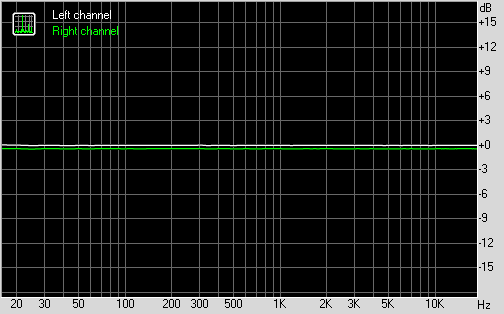
Subjective listening on the other hand is quite a surprise. Given the emphasis from Elekit for having a ‘tube-ish’ sound, I had somewhat expecting TU-HP02 to have a rather warm, if not thick and mellowed sound signature. However, the first impression that comes to my mind during the first listen is that it is actually quite a clean sounding amp, if not approaching what I will usually refer as being ‘transparent’ sounding – a term typically reversed for my reference O2 amp (and that brings back my memory of the TU-HP01’s review, but we will leave it for a later discussion). Further A/Bing between the TU-HP02 and O2 confirms this. TU-HP02 is very much like a slightly richer sounding O2 – a beautified version without any obvious coloration, if you will. The major (or actually the minor) difference is that TU-HP02 isn’t as clearly defined or sharp in each note because there is more ‘room filling’ detail in between each note. Similarly the soundstage seems smaller on the TU-HP02 because of the increase in detail that fills in more space, though a very close back and forth comparison will reveal that TU-HP02’s soundstage by itself is by no mean small in anyway. I guess an analogue will be a room that is totally empty feels ‘more open’ when compared to the same room with one chair in it. Of course what I am describing here are rather subtle in nature and I have a hunch that most people might not able to tell which is which in a brief listening.
So how does it compared to its elder brother, the portable hybrid tube amp TU-HP01 (with MUSES8820) I reviewed awhile back? Well, they are eerily similar in presentation. I said it in the TU-HP01 review that it is hard to really say whether it has a really tube-ish or solid state sound and the same applies to TU-HP02 as well. Looking the other way around, I guess you can say they both have the best of two worlds – but what makes TU-HP02 better is that it doesn’t have any of the downsides of TU-HP01.
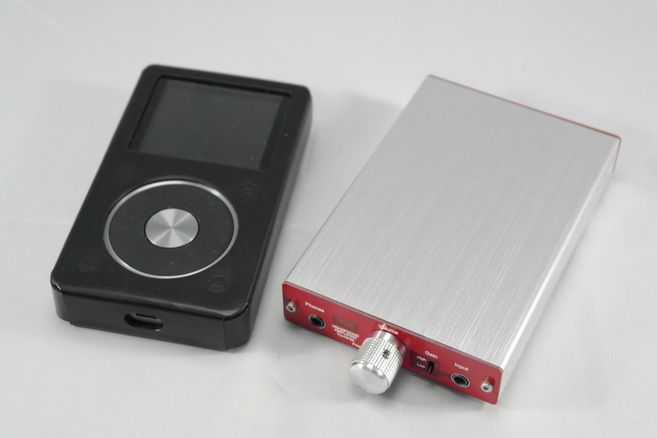
FiiO X5II (left) and TU-HP02 (right)
Sum-up
A thank to both Elekit Japan and VKMusic.ca for the review sample.


Spec
Recommended Headphone Impedance: 16-300ohm
Maximum Output: 170mW @ 16 ohm
Frequency Response: 1Hz-230kHz (-3dB)
Power Supply: 4 x AA battery or 4 x rechargeable NiHM AA battery
Power Consumption: Approx. 40mA (no signal) or 60mA (10mW @ 16 ohm)
Battery Life: Approx. 30 hours of continuous use (10mW @ 16 ohm)
Dimensions: W75 x H19 x D132 mm
Weight: 175g [excl. batteries]
MSRP: US$245

Build Quality
Like the TU-HP01 I have reviewed before, the TU-HP02 has an excellent build quality. The one I received for this review is a pre-production unit so some of the marking are wrong, but otherwise it should be identical to the retail version. The amp takes either 4 AA size batteries and they can be either alkaline or NiHM rechargeable. The front and back panels are basically the same material as the PCB, which is the same style as they have done it on the TU-HP01 and to be frank, quite to my liking. Unscrew it on the back and the whole PCB and front panel will easily slide out of the housing for battery exchange. Battery life is estimated to be around 30 hours depends on volume and load, which is pretty good consider they are running on AA batteries. I am actually still on my first set of batteries as it seems to go on forever and I just give up trying to drain them empty after the first 10 hours.
Gain, Hiss and EMI
Based on my measurement, the two gain settings are rather far apart, with low gain at about -8dB and high gain at around +9dB. Those these number seems a bit more extreme, it actually works out rather well in practise. The low gain setting work best if you have a high output source (i.e. a FiiO’s DAP with well over 1Vrms of line-out) with very sensitive headphone to prevent clipping, while the high gain setting works best with low output source (i.e. Sony’s DAP with under 0.5Vrms of line-out) that needed the voltage boost. They are far more versatile than that of TU-HP01’s gain settings to say the least.
Another area that shows good improvement is hiss. The TU-HP01, being an actual tube amp, suffers from microphonics and the resulting hiss. TU-HP02 on the other hand has no such problem. Hiss is extremely fainted (and arguably inaudible) even with maxed out volume in high gain on my most hiss-prone IEM.
EMI is also excellent with no detectable interference from a cellphone making/receiving call in close proximity. Click and pop during startup is fairly well behaved too.

TU-HP02 (left) and TU-HP-01 (right)
Tech Prelude
So what exactly is this tube’s distortion Elekit has designed into the amp? Well, it is basically referring to the harmonics distortion that comes with a typical triode tube gain stage, and most importantly, the second harmonics that is associated with added body, depth and richness to the fundamental (i.e. with a 1kHz fundamental, the second harmonics will be the double at 2kHz, so on and so forth). Inside the TU-HP02, Elekit has designed a full discrete amp stage that recreates these harmonics distortion and they refer it as the ‘trioderized’ sound.
Sound Quality
As usual, the sound quality evaluation starts with some basic measurements. As far as RMAA’s result goes, TU-HP02’s noise, dynamic range and stereo crosstalk number are pretty good and close to the reference O2. As expected, intermodulation distortion and total harmonic distortion are both noticeably higher due to the purposefully implemented tube-like distortion circuit, though the number are still below the 1% threshold. Frequency response is flat from 20Hz to 20kHz. Output impedance is calculated at 1.4 ohm, which is fairly low. Plenty of current output which means it should have no problem driving even very low impedance headphone. All and all, the numbers look quite solid.

Subjective listening on the other hand is quite a surprise. Given the emphasis from Elekit for having a ‘tube-ish’ sound, I had somewhat expecting TU-HP02 to have a rather warm, if not thick and mellowed sound signature. However, the first impression that comes to my mind during the first listen is that it is actually quite a clean sounding amp, if not approaching what I will usually refer as being ‘transparent’ sounding – a term typically reversed for my reference O2 amp (and that brings back my memory of the TU-HP01’s review, but we will leave it for a later discussion). Further A/Bing between the TU-HP02 and O2 confirms this. TU-HP02 is very much like a slightly richer sounding O2 – a beautified version without any obvious coloration, if you will. The major (or actually the minor) difference is that TU-HP02 isn’t as clearly defined or sharp in each note because there is more ‘room filling’ detail in between each note. Similarly the soundstage seems smaller on the TU-HP02 because of the increase in detail that fills in more space, though a very close back and forth comparison will reveal that TU-HP02’s soundstage by itself is by no mean small in anyway. I guess an analogue will be a room that is totally empty feels ‘more open’ when compared to the same room with one chair in it. Of course what I am describing here are rather subtle in nature and I have a hunch that most people might not able to tell which is which in a brief listening.
So how does it compared to its elder brother, the portable hybrid tube amp TU-HP01 (with MUSES8820) I reviewed awhile back? Well, they are eerily similar in presentation. I said it in the TU-HP01 review that it is hard to really say whether it has a really tube-ish or solid state sound and the same applies to TU-HP02 as well. Looking the other way around, I guess you can say they both have the best of two worlds – but what makes TU-HP02 better is that it doesn’t have any of the downsides of TU-HP01.

FiiO X5II (left) and TU-HP02 (right)
Sum-up
I like the TU-HP01 and TU-HP02 just does it better in every way (except unless you are counting the higher price tag as a negative). While it might not have the opamp rolling capability of its elder brother for the user to customize, it is more refined in design and more practical in use. This makes TU-HP02 an excellent portable amp that I can recommend without reservation.
A thank to both Elekit Japan and VKMusic.ca for the review sample.